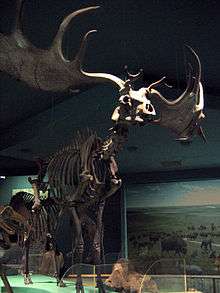Megaloceros
Megaloceros (from Greek: μεγαλος megalos + κερας keras, literally "Great Horn"; see also Lister [1987]) is an extinct genus of deer whose members lived throughout Eurasia from the early Pleistocene to the beginning of the Holocene and were important herbivores during the Ice Ages. The largest species, Megaloceros giganteus, vernacularly known as the "Irish elk" or "Giant elk", is also the best known. They are thought to be most closely related to the living Dama deer.[1][2][3]
| Megaloceros | |
|---|---|
.jpg) | |
| Skeleton of Megaloceros giganteus | |
| Scientific classification | |
| Kingdom: | Animalia |
| Phylum: | Chordata |
| Class: | Mammalia |
| Order: | Artiodactyla |
| Family: | Cervidae |
| Subfamily: | Cervinae |
| Genus: | †Megaloceros Brookes, 1828 |
| Species | |
| |
| Synonyms | |
| |
Biology
Most members of the genus were extremely large animals that favoured meadows or open woodlands. They are the most cursorial deer known,[4] with most species averaging slightly below 2 metres (6 ft 7 in) at the withers. The various species of the Cretan genus Candiacervus – the smallest of which, C. rhopalophorus was just 65 cm (26 in) high at the shoulder – are sometimes included in Megaloceros as a subgenus.

Despite its name, the Irish elk was neither restricted to Ireland nor closely related to either species commonly referred to as elk (Alces alces in British English and other European languages; Cervus canadensis in North American English) but instead is closely related to the fallow deer genus Dama. The genus was part of a Late Neogene Eurasian radiation of fallow deer relatives of which today only 2 taxa remain.(Lister et al. 2005, Hughes et al. 2006).
Although sometimes synonymized with Megaloceros, Praemegaceros, Sinomegaceros and Megaceroides are apparently generically distinct.[5]
Species
Ordered from oldest to youngest
- M. stavropolensis
- Early Pleistocene species from Southwestern Russia.[6][7]
- M. luochuanensis
- Early to Mid-Pleistocene species in the Shaanxi Loess of China.
- M. novocarthaginiensis
- Described from the latest Early Pleistocene 0.9-0.8 Ma of Cueva Victoria in Spain. Known from antlers, teeth and postcranial material.[8]
- M. antecedens
- Very similar to M. giganteus, to the point where it is often regarded as a paleosubspecies of the latter. The antlers were more compact, and the tines near the base large and palmate. Lived in Mid-Pleistocene Germany
- M. savini
- Mid-Pleistocene species, slightly larger than a caribou, first fossils found near Sainte Savine, France and near Soria, Spain. Its antlers were straight, with thorn-like prongs. The lowermost prongs near the base were palmate.
- M. matritensis Van der Made 2019[9]
- Mid-Pleistocene species, lived around 300-400 ka near present-day Madrid, Spain, being contemporary with M. giganteus. The species had enlarged premolars, very thick molar enamel, and a low mandibular condyle. The species itself formed part of the diet of people which lived in the area. M. matritensis fossils are found associated to stone tools of late Acheulean and early Mousterian type. The species is thought to be descended from M. savini
- M. giganteus
- Largest, best known, and among the last species of the genus, about 2 m (6.6 ft) at the shoulders. Lived throughout Eurasia, from Ireland to China during the last Ice Age.
References
- Lister, A. M., Edwards, C. J., Nock, D. A. W., Bunce, M., van Pijlen, I. A., Bradley, D. G., Thomas, M. G. & Barnes, I. 2005. The phylogenetic position of the ‘giant deer’ Megaloceros giganteus. Nature 438, 850-853.
- Mennecart, B., deMiguel, D., Bibi, F., Rössner, G. E., Métais, G., Neenan, J. M., Wang, S., Schulz, G., Müller, B. & Costeur, L. 2017. Bony labyrinth morphology clarifies the origin and evolution of deer. Scientific Reports 7: 13176.
- Gonzalez, S., Kitchener, A. C. & Lister, A. M. 2000. Survival of the Irish elk into the Holocene. Nature 405, 753-754.
- Geist, V. 1999. Deer of the World. Swan Hill Press, Shrewsbury.
- CROITOR, R., 2006. Taxonomy and systematics of large-sized deer of the genus Praemegaceros Portis, 1920 (Cervidae, Mammalia). In: R. D. Kahlke, L. C. Maul, P. P. A. Mazza (Eds.): Late Neogene and Quaternary biodiversity and evolution: Regional developments and interregional correlations. Volume I. Courrier Forsch.-Institut Senckenberg, 256, 91-116.
- M. stavropolensis
- Titov, V. V.; Shvyreva, A. K. (January 2016). "Deer of the genus Megaloceros (Mammalia, Cervidae) from the Early Pleistocene of Ciscaucasia". Paleontological Journal. 50 (1): 87–95. doi:10.1134/S0031030116010111. ISSN 0031-0301.
- Made, J. van der (2015). "The latest Early Pleistocene giant deer Megaloceros novocarthaginiensis n. sp. and the fallow deer "Dama df. vallonnetensis" from Cueva Victoria (Murcia, Spain)". Mastia. 11-13: 269–323 – via Semantic Scholar.
- Van der Made, Jan. 2019. The dwarfed "giant deer" Megaloceros matritensis n.sp. from the Middle Pleistocene of Madrid - A descendant of M. savini and contemporary to M. giganteus. Quaternary International in press. . Accessed 2019-02-04.
Further reading
| Wikimedia Commons has media related to Megaloceros. |
- Hughes, Sandrine; Hayden, Thomas J.; Douady, Christophe J.; Tougard, Christelle; Germonpré, Mietje; Stuart, Anthony; Lbova, Lyudmila; Carden, Ruth F.; Hänni, Catherine; Say, Ludovic (2006): Hughes, Sandrine; Hayden, Thomas J.; Douady, Christophe J.; Tougard, Christelle; Germonpré, Mietje; Stuart, Anthony; Lbova, Lyudmila; Carden, Ruth F.; Hänni, Catherine; Say, Ludovic (2006). "Molecular phylogeny of the extinct giant deer, Megaloceros giganteus". Molecular Phylogenetics and Evolution. 40 (1): 285–291. doi:10.1016/j.ympev.2006.02.004. PMID 16556506.
- Lister, A.M. (1987): Megaceros or Megaloceros? The nomenclature of the giant deer. Quaternary Newsletter 52: 14–16.
- Lister, A.M.; Edwards, C.J.; Nock, D.A.; Bunce, M.; van Pijlen, I.A.; Bradley, D.G.; Thomas, M.G. & Barnes, I. (2005): Lister, A. M.; Edwards, C. J.; Nock, D. A. W.; Bunce, M.; Van Pijlen, I. A.; Bradley, D. G.; Thomas, M. G.; Barnes, I. (2005). "The phylogenetic position of the 'giant deer' Megaloceros giganteus". Nature. 438 (7069): 850–853. Bibcode:2005Natur.438..850L. doi:10.1038/nature04134. PMID 16148942.